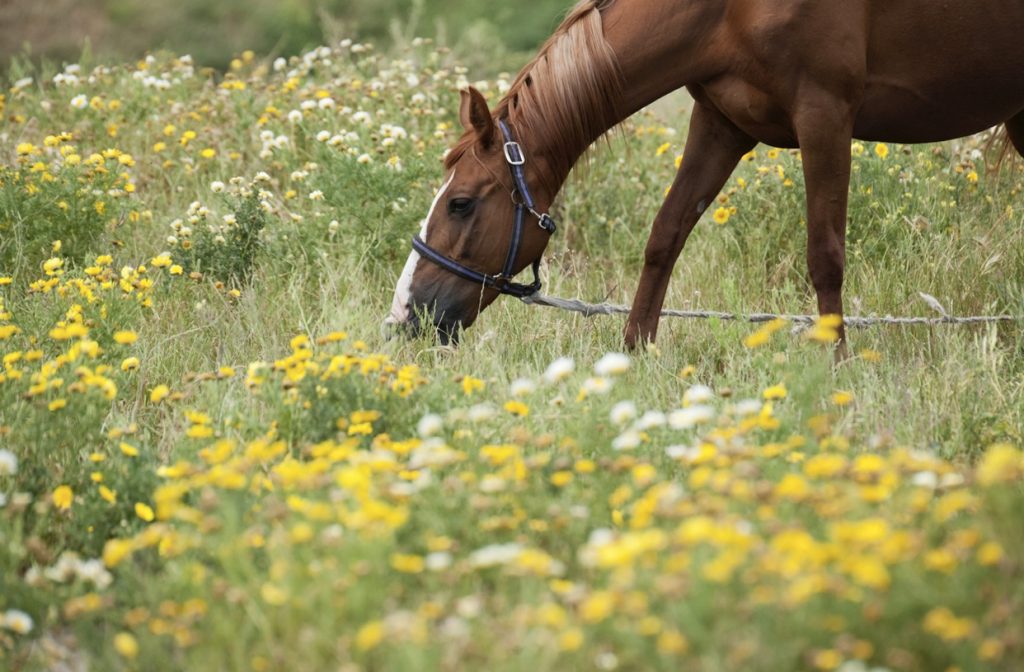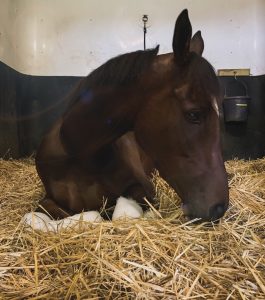
Brought to you courtesy of O3 Animal Health

Our customer reviews tell the story. See them on our site at https://o3animalhealth.com/reviews/
If you are a trainer or breeder and are interested in product testing our products, please contact us kathleen@o3animalhealth.com
We all know that good quality hay should from the basis of any good equine diet. Is there anything in particular that we should look out for in choosing a type of hay to feed?
With forage selection, it is important to look at your horse’s specific needs. When choosing hay for your horse, there are some key things to take into consideration. Maturity is a direct reflection of quality. Immature, nutrient dense forage contains decreased amounts of structural carbohydrates: cellulose, hemicellulose and lignin. As forage matures, the amount of fiber increases to structurally support the plant. Lignin is an organic substance that comprises cell walls and gives rigidity to plants. It also directly interferes with the digestion of cellulose and hemicellulose. Therefore, as concentrations increase with maturity, overall digestibility of the forage decreases. More mature forages are also likely to have decreased energy and protein levels. The average horse can thrive on forage of mid-maturity, however easy keepers do well on more mature forages, while hard keepers require a more nutrient dense, immature forage.
When baled at a similar level of maturity, legumes typically produce forages of higher quality that are more palatable and digestible than grasses. In addition, legumes will generally have higher energy, protein and mineral levels. While legumes are a great option for working horses, it is important to consider the level of maturity, as immature legumes can often exceed your horse’s nutrient requirements. A more mature legume is therefore favored over a less mature one.
There is no, one hay in particular, that we should be feeding. Choosing a hay to offer is really based on the individual horse. Are they an easy keeper or a hard keeper? How old are they? Where are they located? Do they have access to fresh pasture? Forage is the basis to any equine diet. As such, by selecting a hay of specific maturity and plant species, you will fulfill your horse’s individual nutrient requirements, allowing them to grow and develop into the best athlete possible.
How much grain does the average racehorse really need each day (i.e. are the feed bag guidelines accurate if your horse is in good weight and receiving quality hay)?
High-quality forage intake is the foundation of any equine diet. In fact, daily intake for a forage-only diet may exceed 2.5% body weight (dry matter), which is equivalent to upwards of 25 lbs. per day for a 1,000 lb. horse. When considering the diet of exercising horses, energy is our primary concern. The truth is that forage alone cannot typically meet the energy demands of a working horse. As the workload increases, the concentrate to roughage ratio increases. Removing roughage completely from the diet is not an option. The minimum roughage intake is around 1% body weight on a dry matter basis. The average horse is considered to be working at the level of “moderate work” according to the 2007 NRC. These horses make use of primarily aerobic metabolism with spurts of anaerobic metabolism and should be receiving a diet composed of 60% concentrate and 40% forage.
What is the ideal body condition for a racehorse in training and/or competing racehorse?
According to the Henneke body condition scoring system, the ideal body condition is a five. Ideal body condition depends on the use of the animal. Most racehorses are between a 4 and a 5. This system was originally designed to monitor broodmares, as there is an influence of body condition score on reproductive efficiency. The system is particularly useful if body weight cannot be measured. It is a fast and inexpensive way to evaluate your horse’s body condition. The scoring system ranges from one to nine, one being poor and nine being extremely fat. It is based on visual and tactile appraisal of six areas of the body, which include the ribs, behind the shoulder, along the neck, the withers, the crease down the back and the tail head. For a body condition score of five, the ribs are not visually distinguishable, but can be felt, the fat around the tail head feels soft and spongy, the withers are rounded and the neck and shoulders blend smoothly into the body.
What is the best way to put weight on a racehorse?
Along with increased access to good quality, nutritious forage, adding a healthy oil like Equine Omega Complete to the diet is an easy and effective way to add calories and put weight on your horse. Fat has 2.25 times as much energy by weight as carbohydrate. Fat is a source of calm calories that provides increased caloric density without an increase in volume. It does not make your horse hot or overwhelm their system. All oils are essentially equal in energy content, however, it is important to look at the chemical composition to be sure that you are providing a source of good, beneficial fat. Essential omega-6 and omega-3 fatty acids are required in the diet, as they cannot be made inside the body. Omega-6’s promote blood clotting, inflammation and immune system responses, however if these processes get carried away, they can actually become more harmful than helpful. The diet must therefore contain the correct proportion of omega-6 to omega-3 fatty acids in order to keep these processes in check. Equine Omega Complete is made from all natural, GMO-free, mechanically expelled soybean oil with added human grade, deep water, wild caught fish oil. It has a balanced ratio of omega-6 to omega-3 fatty acids, mimicking the fatty acid content of fresh pasture grass that many domesticated horses are lacking.
Do horse owners tend to over-feed or under-feed supplements?
While forage alone does not meet the energy demands of a working horse, supplementing on top of added grain depends on the horse in question. What is their work level? What is their medical history? Although additional supplementation can be necessary, horse owners, in general, tend to over-supplement. In fact, over-supplementing is becoming a more frequent and costly problem. Concentrate feeds and fats supply additional energy for equine athletes on top of high quality forage. Commercial feeds designed for working horses typically supply a balance of the appropriate vitamins and minerals and often include pro and prebiotics for added digestive support. Additional supplementation varies from horse to horse. In order to avoid to doing more harm than good, veterinarians and equine nutritionists should be consulted before any extra supplements are added to your horse’s dietary regimen.
What should owners look for in a supplementation program?
With the help of a veterinarian or an equine nutritionist, owners should design a supplementation program that fits their horse’s specific needs. While horses in general do not require much additional supplementation, this is an area that can be shaped specifically around an individual horse’s requirements. For example, putting weight on a highly stressed or geriatric horse. After investigating for a possible pathogenic condition, you can increase the caloric density of the diet by offering high quality forage and concentrates with added fat. This option does not make sense for all horses. For example, increasing the dietary fat content of an overweight horse or a horse in ideal condition would cause more harm than good. In the case of the “hard keeper,” an explicit dietary regimen that includes added fat is designed specifically for that horse to help promote weight gain.
How do good fats benefit the horse?
There are many benefits to supplementing good fat, including reduced joint and tissue inflammation and the development and maintenance of healthy immune and digestive systems. However, it really starts at the cellular level. Every cell in the body is surrounded by fat and this fat is a direct reflection of what is provided in the diet. Omega-3 and omega-6 fatty acids compete for incorporation into the cell membrane. When greater quantities of omega-3 fatty acids are present in the diet, they are integrated into the membrane at the expense of omega-6 fatty acids. As part of the cell membrane, omega-3 fatty acids increase fluidity, flexibility, permeability and the activity of enzymes that bind to the membrane. Omega-3 fatty acids have a key function in the formation, growth and regeneration of cells and in the transmission of cell signals throughout life. Therefore, by providing a good source of fat in the diet, we can directly influence cell development and function, and ultimately every system in the body. Because both Omega 6 and Omega 3 work together in the horse’s system, most equine nutritionists place more importance on having a balance between the two rather than focusing on the total quantity of either omega-3 or omega-6 individually.
Is there such thing as feeding too much fat to a horse?
Horses cannot really overdose on fat. In fact, the upper limit of fat inclusion in the equine diet has not been established for all sources of fat. Nevertheless, there is a point where fat will no longer absorb efficiently or horses will no longer accept it based on palatability and texture preferences. The truth is, there is no set limit for horses in general, as every horse is different. Some horses will develop loose, greasy feces with low levels of fat added to the diet, while some can tolerate high quantities of fat without any apparent digestive complication. Despite being no set limit for fat inclusion in the equine diet, a general consensus of rations below 230 g fat/kg dry matter is considered acceptable.
Our customer reviews tell the story. See them on our site at https://o3animalhealth.com/reviews/
If you are a trainer or breeder and are interested in product testing our products, please contact us kathleen@o3animalhealth.com
Always check with Past the Wire for the latest horse racing news and more…..


